

Arm Plyometrics
The following is a selection of plyometric exercises designed to develop the elastic strength of the upper body.
Chest Pass
Resources
This exercise requires an assistant and a medicine ball.
How to perform the exercise
|
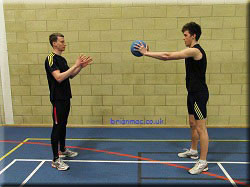 |
How much
- 3 sets of 10 repetitions/set.
- 5-minute recovery between each set.
- The quality of the passes is far more important than quantity.
Power Drop
Resources
This exercise requires an assistant, a 40-100cm box and a medicine ball.
How to perform the exercise
|
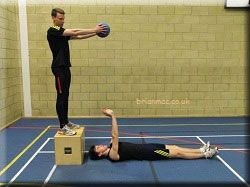 |
How much
- 3 sets of 10 repetitions/set.
- 5-minute recovery between each set.
- The quality of the catch and pass is far more important than quantity.
Incline Push up depth jump
Resources
This exercise requires two thick (3") mats and a 12" box.
How to perform the exercise
- The two mats are placed shoulder-width apart.
- Place the box to elevate the athlete's feet above their shoulders when in a press-up position.
- The athlete:
- Faces the floor in a press-up position with their feet on the box and their hands between the mats.
- Pushes off from the ground with their hands and lands with one hand on each mat.
- Pushes off the mats with both hands and back to the starting position.
- Keep the hand contact time on the mats as short as possible.
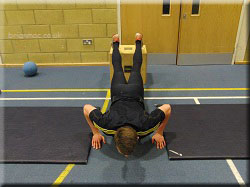 |
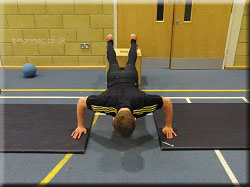 |
How much
- 3 sets of 10 repetitions/set.
- 5-minute recovery between each set.
- The quality of the push-ups is far more important than quantity.
Incline Chest Pass
Resources
This exercise requires an assistant and a medicine ball.
How to perform the exercise
|
 |
How much
- 3 sets of 10 repetitions/set.
- 5-minute recovery between each set.
- The quality of the passes is far more important than quantity.
Vertical Toss
Resources
This exercise requires an assistant, a 40-100cm box and a medicine ball.
How to perform the exercise
|
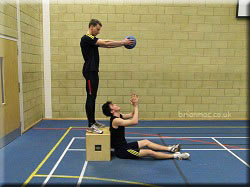 |
How much
- 3 sets of 10 repetitions/set.
- 5-minute recovery between each set.
- The quality of the passes is far more important than the quantity.
Catch and throw backhand
Resources
This exercise requires an assistant and a medicine ball.
How to perform the exercise
- The athlete stands with their feet shoulder-width apart.
- The athlete bends their right arm to 90 degrees and tucks their elbow into their side.
- The athlete keeps their trunk facing forward throughout the exercise.
- The athlete rotates the right arm out, ready to catch the medicine ball.
- The assistant stands to the athlete's right and throws a small medicine ball at the athlete's right hand (Figure 1).
- The athlete catches the medicine ball, takes the medicine ball across the front of the body and throws the medicine ball back to the assistant (Figures 2, 3, 4).
- The athlete should keep their right elbow on their side at all times and focus the effort on their right rear shoulder and external rotator muscles.
- The exercise is repeated for the left arm with the assistant standing on the left side.
- The athlete should try to anticipate the catch and return the medicine ball as quickly as they can, keeping the catch time as short as possible.
 Figure 1 |
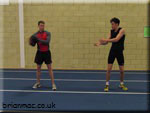 Figure 2 |
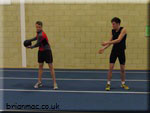 Figure 3 |
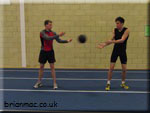 Figure 4 |
How much
- 3 sets of 10 repetitions/set.
- 5-minute recovery between each set.
- The quality of the throws is far more important than the quantity.
Warm-Up and Cool Down
A thorough warm-up is essential before plyometric training. Attention should be given to jogging, stretching (dynamic), striding and general mobility, especially to the joints involved in the planned plyometric session. A cool-down should follow each session.
Page Reference
If you quote information from this page in your work, then the reference for this page is:
- MACKENZIE, B. (2000) Arm Plyometrics [WWW] Available from: https://www.brianmac.co.uk/armplyo.htm [Accessed